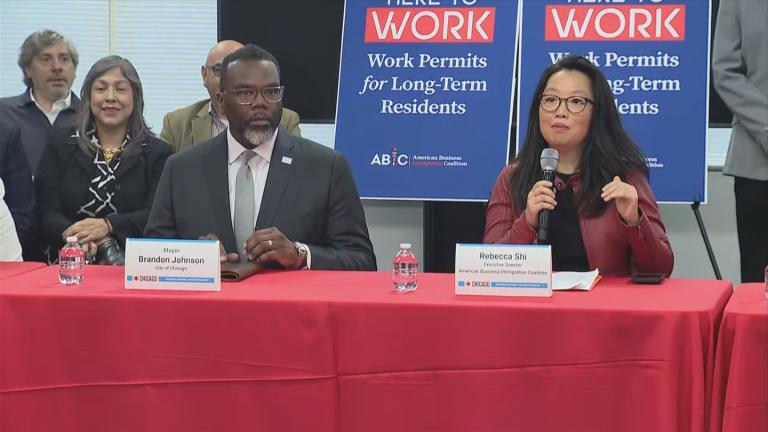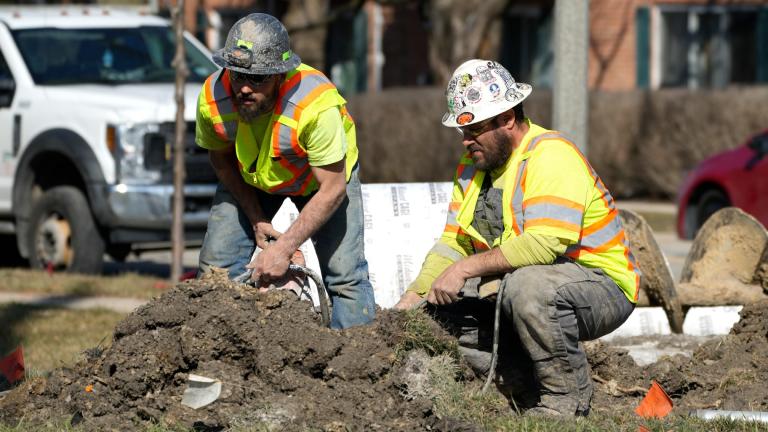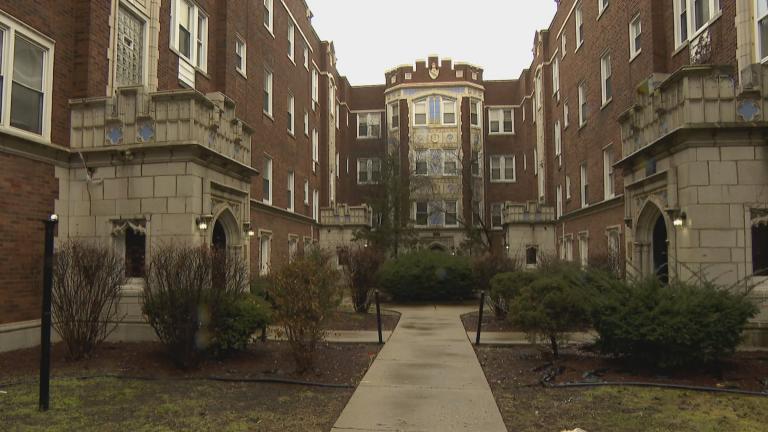It wasn’t all that long ago when the biggest construction project Sheila Jones had taken on was putting together an IKEA closet for her daughter.
“And that took a long, long time and then looking back I’m like there are so many things I did wrong with it, which I’m now going to go back and fix,” she said.
Forget IKEA. Jones also wants to fix the ramshackle steps of her back porch, and she now has the tools to do it.
She is part of what Chicago Women in Trades says is the regional unions’ first class of all women in 140 years.
Eight weeks into their nine-week program, Jones and her peers have learned to erect scaffolds and to maneuver aerial lifts.
“We’ve done wood framing so like this, building up houses, building up walls, we’ve done concrete form building so building foundations, things like that,” she said.
It’s all part of the Mid-America Carpenters Regional Council’s pre-apprentice program that will put Jones on the path to becoming a union-card-holding carpenter.
At age 36, it’s a huge career switch for Jones.
“I was actually working as a nursing home case manager for chronically mentally ill patients, residents. And that was during the height of COVID. And it just become too overwhelming. I have two kids at home, so when their schools closed I just it couldn’t do it anymore, it just became just way too much,” Jones said.
She had been making between $40,000-45,000 a year with no room for her paychecks to increase. As a journeyman — make that journeywoman — she stands to make more, plus a pension and healthcare.
Classmate Caiti Maloney said she too took a circuitous route to get here, working stints as a camera operator and a realtor.
“I’ve had a ton of jobs, I worked at a restaurant at one point, I worked at a Toys R Us in New York City. It’s been an adventure. But I’ve always really enjoyed being hands on and getting a chance to put things together and to really feel like there was a result to the work that I was doing,” Maloney said.
After soul searching, she nailed down what she wants to do: Be a carpenter.
Maloney says as a kid, she would build things with her grandpa and dad.
“With my mom and my grandmother they wouldn’t have had an opportunity to go into these types of fields even if they were interested,” she said. “So, I know I’ve talked to my mom before and she said when she was in school her choices were to be a secretary or to be a nurse. So she became a nurse.”
According to a 2020 report from the Illinois Department of Labor, there still aren’t a lot of women in the trades.
In 2020, women made up 4% of those in trade apprenticeship programs.
Programs like this could change that.
Unions are under pressure to do so from governments with minority contracting rules.
Big area projects will also create opportunities. The Obama Presidential Center promises 50% of its work will be done with minority, women, or veteran-owned businesses, and 50% of on-site construction will be performed by Chicago residents.
Vince Sticca, director of the Mid-America Carpenters Regional Council Apprentice & Training Program, said woman have been carpenters for a long time. He trained with a woman in his pre-apprenticeship class in 1974. Women rose through the ranks to become foremen and supervisors.
“Women were accepted. You know you always have somebody that you know has to make a comment, but mostly everybody has worked with everybody,” Sticca said. “You have to work with everybody. The way you build a building is with a group of people. That’s the only way that construction works. If you pass by a building, there’s a group of people there, it’s not one person. It’s not one woman. It’s not one man. It’s a group of people that are building a building.”
To get into the program, would-be apprentices have to pass a math and aptitude test.
No experience with a hammer and nail or circular saw necessary, they’ll learn.
Physical fitness is another element of training because being a carpenter’s a physically demanding job. Every morning begins with push-ups, carrying 16-foot scaffolding planks and 2-by-4 studs.
Jones said she started off feeling sore; as the program’s nearly done, her body has become conditioned to it.
Even if there are stigmas against women having the ability to do the work, Jones said she’s undaunted.
“I don’t care about what society things … cause I’m able to do it, so I’m going to do it,” Jones said. “I definitely think (stigmas) are still there. Because otherwise, I think more women would be in the trades.”
Having other women to go through it with is encouraging.
“And then we just have this, I guess, network to fall back on,” Jones said. “Once we actually get out into the real world, get onto these job sites, we can ‘lemme call Kate or let me call Caiti, or let me call Ashyaa.”
Maloney said being surrounded by women, and only women, is an opportunity to not be challenged on whether they deserve to be there, based on their gender.
“It gives us an opportunity to be in this place, and be learning and have all of our focus be on learning and preparing for the trade and not worrying about what anyone else things of us while we’re here,” Maloney said.
An opportunity they won’t get in the real world.
The instructor (a woman) said she isn’t certain she’ll recommend an all-women’s program in the future.
Members of the class have discussed that their training doesn’t mirror reality.
Once they’re full-fledged carpenters the trainees will work on crews made of mostly men, as pre-apprentice Christy Fell is doing right next door, where she is the only woman among more than a dozen men.
“I think there are stereotypes. Especially with woman being weaker, or emotional,” Fell said. “But when you break it down, everybody has a bad day, everybody has their flaws and weakness and that’s the point of meeting in this guys’ class. To point out that we can carry each other in different strengths and weaknesses.”
Fell says she would enjoy what she called the “sisterhood of the traveling pants” atmosphere of the all-women’s course across the wall, but said she is using her training as an opportunity to teach and encourage the mostly younger men she’s learning alongside.
“To have an impression on them of what it could be like working with a woman in the force, being uncomfortable with it, getting them ready for it,” Fell said. “It makes it so it’s more accepting, being with somebody different from them. Minority acceptance from the get-go.”
The inaugural class of all-women carpenters will graduate from their pre-apprenticeship program at a special ceremony May 13.
Chicago Women in Trades, which worked with the carpenters’ union to organize the initial cohort, is planning other women-only trainings in the future, including a program with the Teamsters. CWIT also offers other programs for women interested in plumbing, pipefitting or other trades.
Follow Amanda Vinicky on Twitter: @AmandaVinicky








